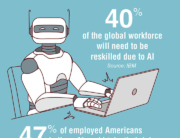Developments from the Staffing Industry Daily News and The Staffing Stream to help you focus on emerging movements that could shape your business for the better.
Work Less, Do More?
Unlimited vacation can boost productivity.
Thirty-nine percent of advertising and marketing executives believe office output would increase if employees could take time off whenever they wanted, as long as their performance didn’t suffer, according to research from The Creative Group. However, 72% of executives and 56% workers said the amount of vacation they would take would remain the same if there were no limit to their personal holidays.
Think Global
Why even local firms need to keep an eye on world events.
Most domestic companies tend to concentrate on their local market and not pay much attention to what is happening around the world and in the area of international business. But even if you are not selling to foreign clients, the state of the world economy may affect you.
For example, say your local staffing firm serves a local manufacturing company. How would world events affect this staffing firm? For one, the euro has depreciated by 24% against the dollar, meaning US consumers can buy foreign goods at a discount.
Alternatively, US-made products are that much more expensive. Those domestic producers using your services may be faced with the fact that their products could be pricey if they have to compete with European suppliers. Similarly, they may need less manpower requirements as well.
Goodbye 9-5
It’s no longer the way to make a living.
The traditional eight-hour work day may be on its way out, according to a survey by CareerBuilder. The survey found 63% of workers in IT, financial services, sales, and professional and business services — industries that historically have more traditional work hours — believe “working nine to five” is an outdated concept. And nearly one quarter, 24%, check work emails during activities with family and friends.
Desperate Measures
Some of the strangest stunts job seekers have tried.
Hiring managers shared with CareerBuilder some of the most unusual ways candidates have gotten their attention but not necessarily the job. Tactics ranged from giftwrapping their resumes; having a child call the hiring manager — before the interview — to say thanks for giving her dad a job; and acting like a game show host.
Not Hiring
Fewer IT execs plan to increase hiring.
According to a TEKsystems’ quarterly “reality check” survey conducted in June, fewer IT leaders planned to increase both traditional and contingent hiring this year compared to similar surveys earlier this year. Of 240 IT leaders, 29% planned to increase temporary hiring, down from 51% in a similar survey in March and 36% in a survey at the beginning of the year.
Operation Retention
Develop quality retention plans to reduce turnover, save money.
Today, the average worker stays at his or her job for 4.6 years, according to the US Bureau of Labor Statistics. Meanwhile, replacement costs can reach as high as 50% to 60% of each employee’s annual salary, with total costs associated with turnover ranging from 90% to 200% of annual salary.
In addition to creating solutions to problems causing turnover, you need a proactive plan to achieve and maintain employee retention. Keep the following steps in mind:
- Benchmark your turnover rate by reviewing how many people have left your organization within the last year.
- Determine what rate of turnover is acceptable for your organization. Not all turnover is avoidable — and some can even be healthy for your organization.
- Invest in your culture. To attract and retain today’s top talent, cultivate an engaging, meaningful work culture.
- Use proven retention strategies. There are a number of retention tactics you can implement today for little to no cost.
- Evaluate your results. Track your progress and overall savings to determine if you are seeing a return on your investment. Adjust accordingly.
Turnover can’t always be prevented, but investing in employee retention and developing people within the organization is proven to be cost-effective. With a proactive retention strategy, you’re one step closer to a lower turnover rate and a more motivated, productive workforce.







